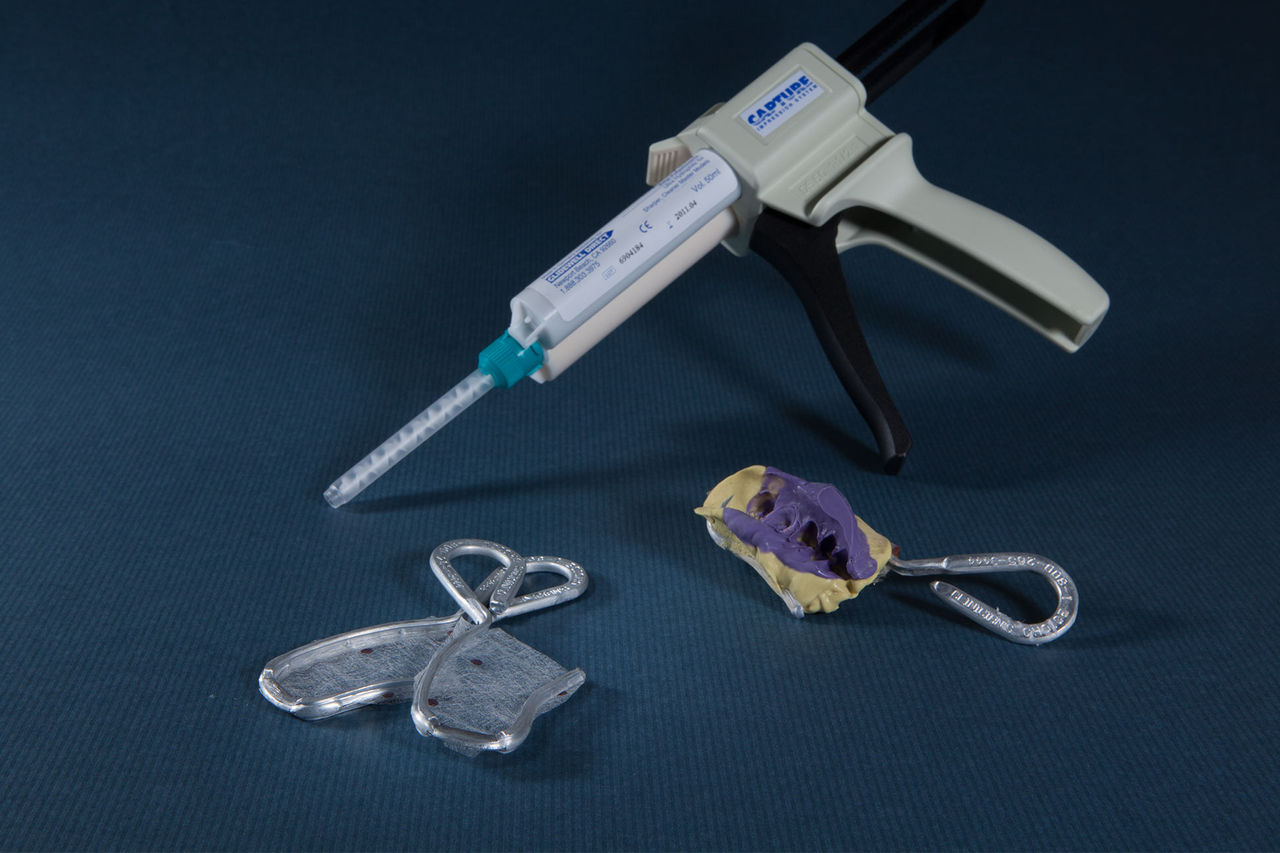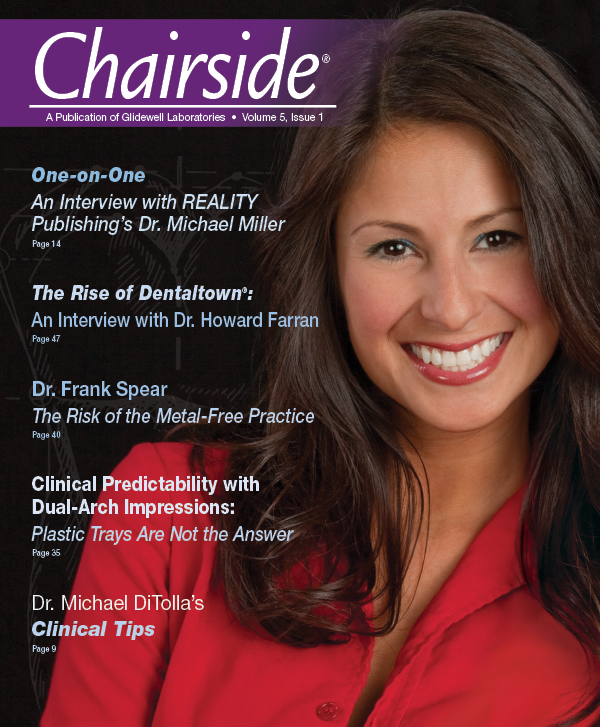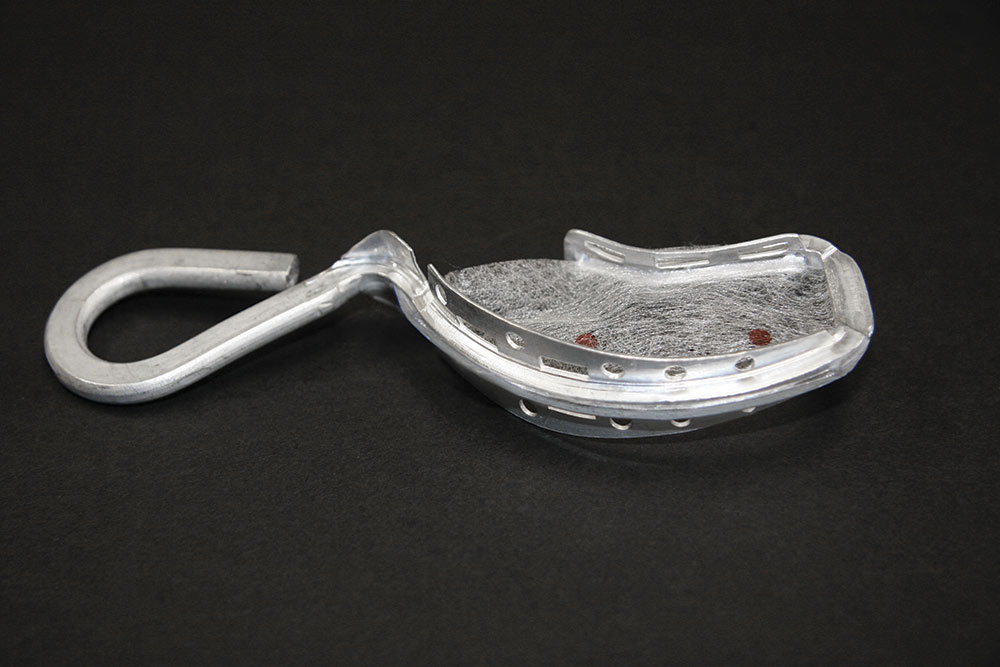Clinical Predictability with Dual-Arch Impressions: Plastic Trays Are Not the Answer

The dual-arch impression technique offers many benefits for single-tooth impressions, which make up the majority of crown & bridge impressions sent to the laboratory. This technique impresses the preparation site and the opposing arch, and registers the bite registration, all at once. It can be used for more than one preparation, and is more economical than taking a full arch impression with polyvinylsiloxane (PVS) combined with a separate impression of the opposing arch and separate bite registration. The dual-arch technique, of course, takes less chairtime. It is also easier for the patient, with less chance of gagging.
Ideally, the dual-arch impression should be used in cuspid rise occlusions, as group function cannot be reproduced on a simple hinge articulator that is often used in the laboratory for these types of impressions. The dual-arch impression should not be used when impressing a terminal tooth in the arch, as many of the plastic articulators used by laboratories can flex, creating occlusal discrepancies on the terminal tooth crown.1 It is imperative that we match the accuracies of the various materials that we use,2 and because there can be a large discrepancy in dimensional accuracy between bite registrations taken with polyvinylsiloxane bite registration materials and alginate derived stone models, this often results in an open bite mounting of the case and hyperocclusion on the prosthesis. Alginate substitutes can create a much more accurate relationship between the PVS bite registration and the casts derived from these impressions. The all-in-one impression is equivalent in marginal accuracy and superior in occlusal inter-digitation to systems using a single upper or lower impression. Studies show that casts made from dual-arch impressions provide more accurate maximal intercuspal relationships than mounted casts from single-arch impressions, resulting in less chairside time seating and adjusting prostheses.3
Accuracy of our impressions is compromised when these plastic dual-arch trays flex as the impression is taken, which results in consistent discrepancies of 180 to 210 microns.
Many dual-arch trays currently being used for dual-arch impressions are plastic. Accuracy of our impressions is compromised when these plastic dual-arch trays flex as the impression is taken, which results in consistent discrepancies of 180 to 210 microns.4 This flex can be caused by the high side walls of the plastic trays hitting the palatal tissues, maxillary tuberosities or tori present in the patient’s oral cavity. Flex can also occur due to outward pressure on the plastic tray when there is interference in the retro-molar pad area. The very act of swallowing during the impression procedure can cause the tongue to repeatedly displace the lingual wall of the tray during polymerization, creating distortion. As well, the thicker rheology of high viscosity impression materials can cause the plastic tray to flex away from the tooth preparation.5 Therefore, when the tray is removed, the plastic memory of the tray will create an inward pressure, and depending on the stiffness of the heavy body used, the dies can be distorted mesio-distally, creating marginal fit problems as well as interproximal contact issues.
The answer is to use a metal tray, which eliminates flex. The QUAD-TRAY® Xtreme™ (Clinician’s Choice; Brookfield, Conn.) (Fig. 1), as reviewed by Dr. Gordon Christensen,6 is designed to complement the dual-arch impression technique and to eliminate the distortion that is common with plastic dual-arch impression trays. Because the tray is fabricated from aluminum, the tray has no elastic memory to create distortion in the final impression. As well, the low sidewalls cannot cause distortion due to axial roll or outward flex, and the design incorporates a wide arch, very thin retro-molar area and is adjustable. Therefore, when combined with the correct heavy body PVS impression material, the impression is dimensionally accurate and stable for an indefinite period of time. Using a “technique designed” specific heavy body is critical to success. If a clinician desires reproducible accuracy and consistent results, the impression material used with a dual-arch tray should be stiffer than the material that is used for full-arch impressions, which are supported by a walled tray that encompasses the entire arch.
When a full-arch impression is taken, the heavy body has to support the light body, but by necessity, it has to have the ability to flex significantly to allow withdrawal of the impression from the oral cavity.
When a full-arch impression is taken, the heavy body has to support the light body, but by necessity, it has to have the ability to flex significantly to allow withdrawal of the impression from the oral cavity. Because the dual-arch impression is essentially a “platform” with no circumferential walls like a traditional tray, the heavy body must be formulated differently to maximize predictability in our crown & bridge prostheses. It has to be very rigid when polymerized because it essentially takes on the function of a tray to support the light body. It also has to be very stiff to resist the deformation forces of pouring up the model in the laboratory. In a recent American Dental Association Professional Product Review,7 the ADA makes the recommendation that heavy bodies, which demonstrate a strain in compression of less than 2% (a very stiff impression material), would work well with a closed bite tray. In my office, for dual-arch impressions I use AFFINITY™ Inflex impression material (Clinician’s Choice), which I’ve found has a very low strain in compression (high stiffness) while still demonstrating the flow necessary to give reproduction of detail. As well, when using the matching light body, the rheology of this heavy body material has been formulated to allow for all of the preparation to be captured in light body, rather than just the gingival collar, resulting in a more accurate fit, with less strain on the physical characteristics of the cementing medium (Figs. 2, 3).
With such a stiff material, when the impression is set, the final impression is held against the prepared arch and the patient is asked to open. Once the opposing arch has been released from the impression, the impression is then carefully rocked from side to side to remove. It must be noted that the patient should not clench during this procedure, as occlusal prematurities on teeth adjacent to the preparation can cause these teeth to move during the impressioning, creating an inaccuracy. Put a hand on the masseter, and when the clinician feels the masseter tighten, make sure the patient releases the pressure but holds the bite lightly. Because the patient cannot always close accurately, especially when anesthetic has been injected, a reference point should be marked anteriorly before anesthesia. Use a small marker to indicate the midline and anterior overbite before the injection takes place, with the patient guided back to this position during the impression.
The original QUAD-TRAY Xtreme has been used to provide excellent impressions because of its rigid metal construction, memory-free aluminum design, impingement preventing sidewalls, wide arch and thin distal bar. A new addition to the QUAD-TRAY family is the QUAD-TRAY XL (Fig. 4), which provides the same benefits but in a full-quadrant design. It extends to the dental midline, and has a perforated, tapered buccal/facial wall and a slotted lingual wall that helps to lock in the impression material without impinging on the palate. By using the QUAD-TRAY XL, the practitioner can provide the laboratory with even more information for precision and accuracy in creating crown and bridge prostheses.
The clinical success of the dual-arch impression is dependent on the combination of proper metal tray and “technique driven” impression material. Laboratories see far too many plastic trays with obvious burn through of hard or soft tissues, reflecting a probable distortion, but the fear of losing clients often dissuades them from returning the case for a new impression. What the laboratories, of course, cannot see is the possible mesio-distal discrepancies caused by memory flex of the plastic tray. In an era where economic turmoil is a reality, neither the laboratory nor the clinician can afford the time, frustration, cost of remakes or time taken to “adapt” an ill-fitting prosthesis.
Dr. Leendert “Len” Boksman is Adjunct Clinical Professor at the Schulich School of Medicine and Dentistry and maintains a private practice in London, Ontario, Canada. He is also a paid part-time consultant to Clinical Research Dental Incorporated and Clinician’s Choice. Contact Dr. Boksman at lboksman@clinicalresearchdental.com or 519-641-3066, ext. 292.
References
- ^Thornton LJ. A survey on the utilization of disposable quadrant articulators. Gen Dent. 2002 Jan-Feb;50(1):72-6.
- ^Boksman L. Point of Care: How do I minimize the amount of occlusal adjustment necessary for a crown? JCDA. 2005 Jul-Aug;71(7):494-5.
- ^Cox JR. A clinical study comparing marginal and occlusal accuracy of crowns fabricated from double-arch and complete-arch impressions. Aust Dent J. 2005 Jun;50(2):90-4.
- ^Carrotte PV, et al. The influence of the impression tray on the accuracy of impressions for crown and bridge work – an investigation and review. Br Dent J. 1998 Dec 12-26;185(11-12):580-5.
- ^Cho GC, Chee WW. Distortion of disposable plastic stock trays when used with putty vinyl polysiloxane impression materials. J Prosthet Dent. 2004 Oct;92(4):354-8.
- ^Christensen G. Dual-arch Impression Summary. Clinicians Report. 2008 Jun;1(6) (also published in J Am Dent Assoc. 2008 Aug:1123-5).
- ^ADA Professional Product Review. Vol. 2, Issue 3. Elastomeric Impression Materials.
Reprinted with permission from Dentaltown® Magazine: Boksman L. Clinical predictability with dual-arch impressions: plastic trays are not the answer. Dentaltown. 2009;10(9):18-21. Copyright ©2009 Dentaltown.com, LLC. Printed in the USA.







